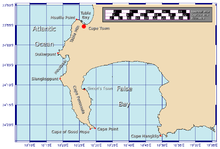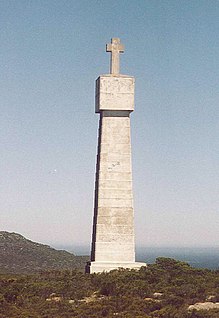Cape of Good Hope


The Cape of Good Hope (Afrikaans: Kaap die Goeie Hoop, Dutch: , Portuguese: Cabo da Boa Esperança) is a rocky headland on the Atlantic coast of South Africa. There is a very common misconception that the Cape of Good Hope is the southern tip of Africa and the dividing point between the Atlantic and Indian Oceans, but in fact the southernmost point is Cape Agulhas, about 150 kilometres (90 mi) to the southeast. However, when following the coastline from the equator, the Cape of Good Hope marks the psychologically important point where one begins to travel more eastward than southward. Thus the rounding of the cape in 1488 was a major milestone in the attempts by the Portuguese to establish direct trade relations with the Far East.
As one of the great capes of the South Atlantic Ocean, the Cape of Good Hope has been of special significance to sailors for many years and is widely referred to by them simply as "the Cape."[1] It is a major milestone on the clipper route followed by clipper ships to the Far East and Australia, and still followed by several offshore yacht races.
The term Cape of Good Hope was also used to indicate the early Cape Colony established in 1652, in the vicinity of the Cape Peninsula. Just prior to the formation of the Union of South Africa, the term referred to the entire region that was to become the Cape Province in 1910.
34°21′29″S 18°28′19″E / 34.35806°S 18.47194°E
Geography

The Cape of Good Hope is located at 34°21′29″S 18°28′19″E / 34.35806°S 18.47194°E.[2] It is at the south-west corner of the Cape Peninsula, about 2.3 kilometres (1.4 mi) west and a little south of Cape Point on the south-east corner. Cape Town is about 50 kilometres to the north of the Cape, in Table Bay at the north end of the peninsula. The peninsula forms the western boundary of False Bay. Geologically, the rocks found at the two capes -and indeed over much of the peninsula- are part of the Table Mountain Group, and are formed of the same type of sandstones as those exposed in the faces of Table Mountain itself.

Both the Cape of Good Hope and Cape Point offer spectacular scenery. Indeed, the whole of the southernmost portion of the Cape Peninsula is a wild, rugged, scenic and generally unspoiled national park.
The term Cape of Good Hope has also been used in a wider sense, to indicate the area of the early European colony in the vicinity of the cape.[3]
History


Some speculate that before European explorers reached the Cape of Good Hope, Chinese, Arabian, or Indian explorers/merchants may already have visited it, and kept records of these visits. The Old World maps like Kangnido and Fra Mauro map made before 1488 may be evidence of this.
The first European to reach the cape was the Portuguese explorer Bartolomeu Dias in 1488, who named it the "Cape of Storms" (Cabo das Tormentas). It was later renamed by John II of Portugal as "Cape of Good Hope" (Cabo da Boa Esperança) because of the great optimism engendered by the opening of a sea route to India and the East.
The land around the cape was home to the Khoikhoi (Hottentot) people when the Dutch first settled there in 1652. The Khoikhoi had arrived in these parts about fifteen hundred years before.[citation needed]
Dutch colonial administrator Jan van Riebeeck established a resupply camp for the Dutch East India Company some 50 km north of the cape in Table Bay on 6 April 1652 and this eventually developed into Cape Town. Supplies of fresh food were vital on the long journey around Africa and Cape Town became known as "The Tavern of the Seas".
On 31 December 1687 a community of Huguenots arrived at the Cape from the Netherlands. They had escaped to the Netherlands from France in order to flee religious persecution there, examples of these are Pierre Joubert who came from La Motte-d'Aigues for religious reasons. The Dutch East India Company needed skilled farmers at the Cape of Good Hope and the Dutch Government saw opportunities for the Huguenots at the Cape and sent them over. The colony gradually grew over the next 150 years or so until it stretched for hundreds of kilometres to the north and north-east.
The United Kingdom invaded and occupied the Cape Colony in 1795 ("The First Occupation") but relinquished control of the territory in 1803. However, British forces returned on 19 January 1806 and occupied the Cape once again ("The Second Occupation"). The territory was ceded to the UK in the Anglo-Dutch Treaty of 1814 and was henceforth administered as the Cape Colony. It remained a British colony until incorporated into the independent Union of South Africa in 1910 (now known as the Republic of South Africa).
The Portuguese government erected two navigational beacons, Dias Cross and Da Gama Cross, to commemorate Vasco da Gama and Bartolomeu Dias as explorers who as mentioned were the first explorers to reach the cape. When lined up, the crosses point to Whittle Rock (34°14.8′S 18°33.6′E / 34.2467°S 18.5600°E), a large, permanently submerged shipping hazard in False Bay. Two other beacons in Simonstown provide the intersection.
In 1992 Rebecca Ridgeway became the first woman to single handedly kayak around the Cape. In 1993 she published a book telling of her adventures titled 'Something Amazing' published by Hodder and Stoughton.
Legends
The Cape of Good Hope is the legendary home of The Flying Dutchman. Crewed by tormented and damned ghostly sailors, it is doomed forever to beat its way through the adjacent waters without ever succeeding in rounding the headland.
Adamastor is a Greek-type mythological character invented by the Portuguese poet Luís de Camões in his epic poem Os Lusíadas (first printed in 1572), as a symbol of the forces of nature Portuguese navigators had to overcome during their discoveries, and more specifically of the dangers Portuguese sailors faced when trying to round the Cape of Storms.
Fauna

With its diverse habitat, ranging from rocky mountain tops to beaches and open sea, the Cape of Good Hope is home to at least 250 species of birds.
"Bush birds" tend to be rather scarce because of the coarse, scrubby nature of fynbos vegetation. When flowering, however, proteas and ericas attract sunbirds, sugarbirds, and other species in search of nectar. For most of the year, there are more small birds in coastal thicket than in fynbos.
The Cape of Good Hope section of Table Mountain National Park is home to several species of antelope. Bontebok and Eland are easily seen, and Red Hartebeest can be seen in the grazing lawns in Smitswinkel Flats. Grey Rhebok are less commonly seen and are scarce, but may be observed along the beach hills at Olifantsbos. Most visitors are unlikely to ever see either Cape Grysbok or Klipspringer.
The Cape of Good Hope section is home to four Cape Mountain Zebra. They might be seen by the attentive or lucky visitor, usually in Smitswinkel Flats.
There are a wealth of small animals such as lizards, snakes, tortoises and insects. Small mammals include rock hyrax (dassie), striped mouse, water mongoose, Cape clawless otter and white deer.
The area offers excellent vantage points for whale watching. The Southern right whale is the species most likely to be seen in False Bay between June and November. Other species are the Humpback whale and Bryde's whale. Seals and Dusky Dolphins or Orca, the Killer Whales may also be seen.
The strategic position of the Cape of Good Hope between two major ocean currents, ensures a rich diversity of marine life. There is a difference between the sea life West of Cape Point and that to the East due to the markedly differing sea temperatures.
The South African Marine Living Resources Act is strictly enforced throughout the Table Mountain National Park, and especially in marine protected areas. Disturbance or removal of any marine organisms is strictly prohibited between Schusters Bay and Hoek van Bobbejaan, but is allowed in other areas during season and with relevant permits.
Chacma Baboons
Chacma Baboons (Papio ursinus) are the mammal most intimately associated with the Cape of Good Hope. Baboons inside the Cape of Good Hope section of the park are a major tourist attraction. They've lived on the Cape Peninsula for approximately one million years and continue to this day. There are 11 troops consisting of about 375 individuals throughout the entire Cape Peninsula. Six of these 11 troops either live entirely within the Cape of Good Hope section of the park, or use the section as part of their range. The Cape Point, Kanonkop, Klein Olifantsbos, and Buffels Bay troops live entirely inside the Cape of Good Hope section of the Park. The Groot Olifantsbos and Plateau Road troops range into the park.
Chacma Baboons are widely distributed across Southern Africa and are classified as "least concern" in the IUCN Red List of Threatened Species. However, the South African Parks Dept. states in its publication Mountains in the Sea that the baboon population on the Cape is "critically endangered." This is due to habitat loss, genetic isolation, and conflicts with humans. Cape baboons have been eliminated from the majority of their range across the Cape Peninsula, and the Cape of Good Hope section of Table Mtn. National Park provides a sanctuary for the troops that live within its boundaries. It provides relative safety from nearby towns, where people have killed many baboons after the baboons raid their houses looking for food. Baboons are also frequently injured or killed outside of the park by cars and by electrocution on power lines. Inside the park, some management policies such as allowing barbecues and picnics in the baboon home ranges cause detriment to the troops, as they become embroiled in conflicts with guests to the park.
Flora
The Cape of Good Hope is an integral part of the Cape Floristic Kingdom, the smallest but richest of the world's six floral kingdoms. This comprises a treasure trove of 1100 species of indigenous plants, of which a number are endemic (occur naturally nowhere else on earth). Two types of fynbos ("fine bush"), coastal fynbos on alkaline sands and inland fynbos on acid soils, are found.
Characteristic fynbos plants include proteas, ericas (heath), and restios (reeds). Some of the most striking and well-known members belong to the Proteacae family, of which up to 24 species occur. These include King Protea, Sugarbush, Tree Pincushion and Golden Cone Bush.
Many popular horticultural plants like pelargoniums, freesias, daisies, lilies and irises also have their origins in fynbos.
See also
- Cape Horn, its South American counterpart
- Western Cape
- History of Cape Colony
References
- ^ Along the Clipper Way, Francis Chichester; page 78. Hodder & Stoughton, 1966. ISBN 0-340-00191-7
- ^ Topo map of the Cape of Good Hope, from the South African Geographical Names System
- ^ Historic Cape of Good Hope Land Grants and related histories
